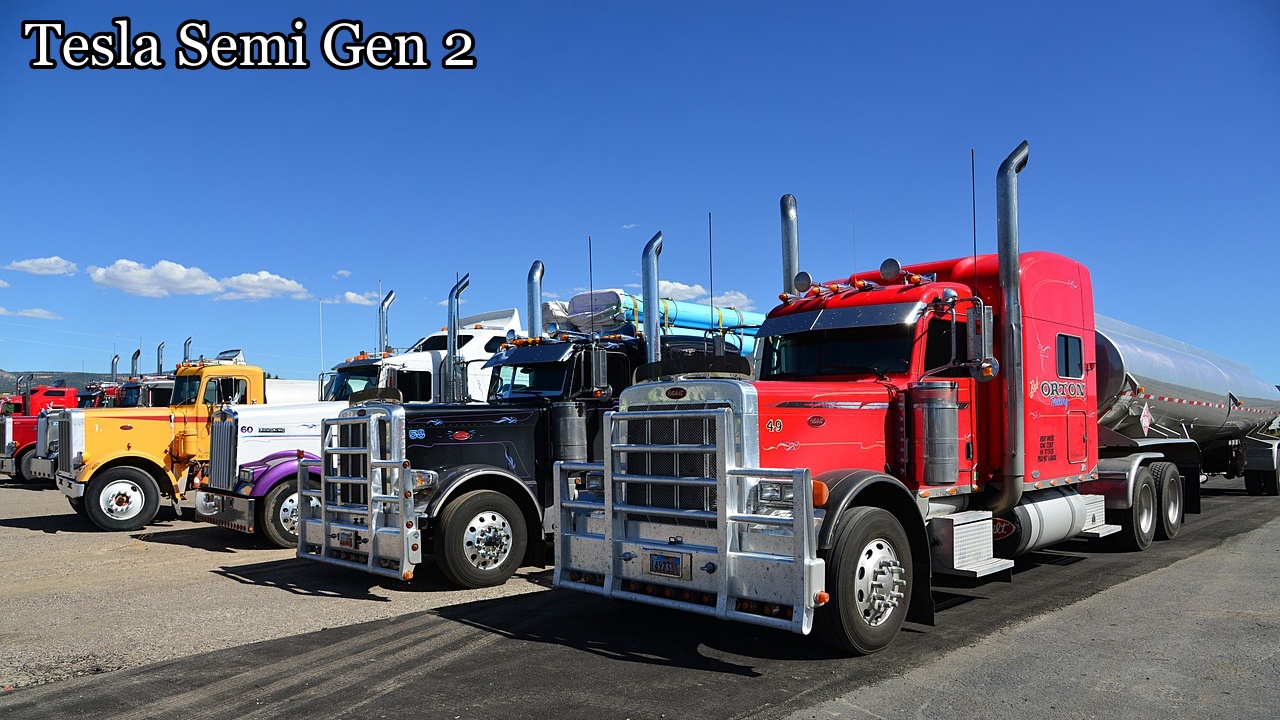The Tesla Semi, currently still in its first generation, is set to undergo a significant upgrade. This year, alongside the opening of a new factory, Tesla will launch the Tesla Semi Gen 2, bringing a host of exciting changes. From improved battery technology to new design features, the Tesla Semi Gen 2 is poised to redefine the electric trucking industry.
What’s New with Tesla Semi Gen 2?
Elon Musk has confirmed that the Tesla Semi Gen 2 will come with a major battery upgrade. The new battery technology will offer significant improvements in efficiency, performance, and range, helping businesses reduce operating costs and increase profits. Musk’s ambitious goal is for the new Semi to generate $1 billion in revenue per month, which would translate to over $1 billion annually with large-scale production.
Along with the new battery, Tesla is also ramping up its production capacity to meet the growing demand for electric big rigs. The new factory in Nevada is designed to produce 50,000 Tesla Semis annually, enabling Tesla to deliver trucks to customers who have pre-ordered, and new customers will also be able to purchase the Semi by the end of this year.
Lower Operating Costs: The Tesla Semi’s Major Advantage
Many still mistakenly believe the Tesla Semi is just another electric truck with nothing extraordinary to offer. However, the numbers don’t lie. When it comes to operating costs, the Tesla Semi is a money-printing machine for the transportation industry.
Operating Costs Comparison
- Tesla Semi Operating Cost: The Tesla Semi’s operating cost is just 85 cents per mile, compared to an average of $1.51 per mile for diesel trucks. This significant difference translates into major savings for transportation companies over time.
- Energy Efficiency: The Tesla Semi consumes only 1.6 to 1.7 kWh per mile, a figure no competitor can match. For instance, with the average electricity price in California, driving 6.5 miles would cost only $3.30, while a diesel truck would cost $3.66.

Maintenance Costs: Tesla Semi vs Diesel Trucks
Another breakthrough feature of the Tesla Semi is its minimalist design and the elimination of many components that require frequent maintenance in traditional diesel trucks.
- Tesla Semi Maintenance Costs: Tesla estimates that the Semi’s maintenance cost is just 10 cents per mile, totaling $50,000 over 5 years if driven 100,000 miles per year.
- Diesel Truck Maintenance Costs: In comparison, a diesel truck has maintenance costs of about 20 cents per mile, leading to $100,000 in maintenance costs over the same period, which is double that of the Tesla Semi.
With fewer parts to maintain and no internal combustion engine, the Tesla Semi drastically reduces downtime and maintenance-related disruptions, giving businesses a major advantage.
A Superior Driving Experience
The Tesla Semi is not only more efficient but also safer and more powerful than traditional diesel trucks. For example, the Semi can accelerate from 0 to 60 mph in just 20 seconds, even with a full load on a 10% incline, a feat impossible for diesel trucks, which would risk tipping over under such conditions.
Tesla Semi Performance
With a range of up to 500 miles on a single charge, the Tesla Semi Gen 2 is far ahead of its competitors in terms of long-haul capabilities.
Full Self-Driving: The Future of Trucking
One of the most exciting developments for the Tesla Semi is the integration of full self-driving (FSD) technology, which will be rolled out in the near future. This technology will be a game-changer for the transportation industry, offering several key benefits:
Alleviating Driver Fatigue
Full self-driving will help reduce the pressure on truck drivers, allowing them to rest during long trips while the truck drives itself. This feature could significantly reduce the risks associated with driver fatigue, such as accidents and health issues.
Addressing the Truck Driver Shortage
The trucking industry is facing a severe driver shortage, with fewer people entering the profession due to its demanding nature. Full self-driving technology will alleviate this issue by enabling trucks to operate autonomously for long stretches, reducing the need for continuous human intervention.
The Tesla Semi’s Impact on Sustainability
Sustainability is becoming increasingly important in the transportation industry, and the Tesla Semi is well-positioned to meet the demand for zero-emission vehicles. Heavy-duty trucks account for only about 1% of all vehicles on the road but contribute to nearly 20% of global emissions.
Zero Emissions
The Tesla Semi will help reduce harmful emissions, aligning with global efforts to phase out diesel trucks and meet stricter environmental regulations.
Sustainability Leadership
By switching to electric trucks, companies can gain a competitive advantage while positioning themselves as leaders in sustainability.
What’s Next for the Tesla Semi?
Tesla is investing heavily in the second-generation Tesla Semi, which is expected to begin full-scale production later this year. This new version will feature Tesla’s latest 4680 battery cells, offering improved performance, efficiency, and driving range. Additionally, the Gen 2 Semi will include a redesigned sleeper cabin and other enhancements aimed at improving driver comfort and efficiency.
However, scaling up production is always a challenge. While manual assembly is still required for the Tesla Semi, Tesla’s confidence in its new factory and the increasing demand for electric trucks will likely drive rapid progress in production.
Conclusion: The Tesla Semi Could Revolutionize the Transportation Industry
With its innovative features, lower operating costs, reduced maintenance needs, and the integration of full self-driving technology, the Tesla Semi is positioned to revolutionize the trucking industry. As businesses increasingly prioritize sustainability, Tesla’s electric big rigs provide a zero-emission solution that is both cost-effective and eco-friendly.
As Tesla ramps up production of the Tesla Semi Gen 2 and addresses the challenges of scaling production, it could soon become the leading choice for businesses looking to modernize their fleets. Will the Tesla Semi be the electric truck that replaces diesel rigs in the decades to come? Only time will tell, but one thing is for sure: the future of trucking is electric.
FAQ
The Tesla Semi Gen 2 introduces a significant battery upgrade, moving to Tesla’s new 4680 battery cells, which promise better efficiency, performance, and range. Additionally, the Gen 2 model will feature a redesigned sleeper cabin for drivers and improvements in overall truck design for enhanced durability and comfort.
The Tesla Semi offers lower operating costs and reduced maintenance compared to diesel trucks. Its operating cost is just 85 cents per mile, while a diesel truck typically costs $1.51 per mile. Maintenance costs for the Tesla Semi are also lower, with an estimated $50,000 over five years versus $100,000 for diesel trucks.
The Tesla Semi excels in challenging conditions, accelerating from 0 to 60 mph in just 20 seconds, even with a full load on a 10% incline. This is a remarkable feat, as diesel trucks are prone to tipping over under similar conditions due to their engine limitations.
The Tesla Semi Gen 2 offers a range of up to 500 miles on a single charge, making it one of the top performers in the electric truck market. This extended range is a significant advantage for long-haul trucking compared to many of its competitors.
Tesla plans to integrate full self-driving (FSD) technology into the Tesla Semi in the near future. This will allow the truck to handle long trips autonomously, offering benefits such as reduced driver fatigue and increased safety. However, drivers will still need to intervene in complex situations like parking or changing traffic conditions.
Read More:

